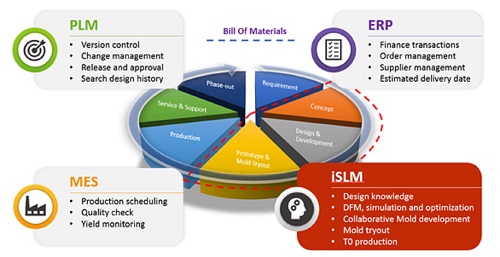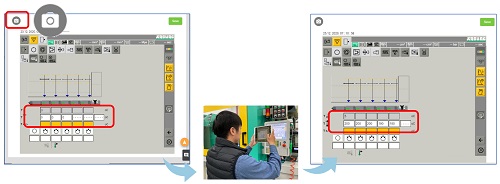When it comes to useful tools that can enhance teamwork efficiency, we usually think of the Product Lifecycle Management (PLM) systems. However, for the plastic part and mould designers, general-purpose PLM systems might not be satisfactory enough. The reason is that they cannot fully cooperate with the time-demanding yet complicated plastics mould development process, and it is usually too costly for small and medium-sized enterprises to adopt.
Plastics mould making has its unique design and manufacturing process. Frequent design changes and short delivery time make the situation even more challenging. Also, due to the high entry barriers of this industry, knowledge and skill gaps tend to occur. Under these circumstances, the preservation and inheritance of design experiences are extremely critical for enterprises today.
PLM focuses on managing the overall product lifecycle. It does not provide comprehensive features to bring design and engineering data together. The industry needs a platform to help acquire design and moulding knowledge, and organise them in readable, searchable, and visualisable formats for future utilisation. However, useful tools for tracing the design-optimisation process, instant sharing and visualisation of simulation results, comparing mould tryout and quality inspection data are missing in most PLM systems.

iSLM completes product development lifecycle management with its comprehensive capabilities
Every new plastic part and mould development involves many stages and different talents, such as product design, mould design, mould manufacturing, mould tryout, and production. When receiving a new project from an internal request or external customer via PLM, the design manager usually holds a preliminary Design for Manufacturing (DFM) meeting to determine the part requirements for preparing a quote. Numerous design and simulation iterations will then be performed in order to decide the gate number, locations, and sizes, improve flow balance, optimise runner system and water circuits, estimate cycle time and deal with potential shrinkage and warpage problems, etc. After the final mould design is concluded, the mould steel is cut and assembled for the first mould tryout (T0). Before T0, it would be very helpful to receive advice from simulations in order to optimise process conditions. Tool debug, part optimisation, and mould tryouts are further proceeded to yield acceptable parts with competitive cost.
The above-mentioned process is critical to the long-term competitiveness of each company. However, different engineers oversee various stages in the whole process, and their data is usually stored in many different software, hardware, or file systems. To ensure a streamlined workflow and traceability, it is necessary to integrate and systemize these scattered data on one single platform.
Different from general PLM systems, iSLM is a web-based platform that can record various mould design data, such as material data, machine specifications, Mouldex3D CAE analysis projects, mould information, mould tryout conditions, and moulding results, etc. Users can access this data management platform through a browser on any device anywhere.
Only one click is needed to upload Mouldex3D projects to iSLM. The system can automatically extract the representative information of project data, including run information, models, materials and processing conditions, etc. iSLM supports instant 3D visualisation of analysis results. It is not needed to download the entire project back to users’ local desktop computers for visualisation. Team members or clients can view the analysis data through browsers and collaborate in real-time.
When recording process settings, it would make the most sense to connect the moulding machines with iSLM via a Manufacturing Execution System (MES). However, due to the low level of digitalisation of most injection moulding shop floors, it is not uncommon that many factories are still recording process conditions on paper. Companies should not wait until all their machines are connected to the network before starting to build their moulding knowledge database, risking losing valuable moulding experiences and talents every day. iSLM provides tools that can help collect the moulding parameters of on-site mould tryouts. It can cover complete process parameters, including the temperature control of the screw regions, mould opening and closing settings, screw plasticisation, suck back and forth settings, and stroke settings (injection, packing, ejection, etc.). For some moulding machine types, iSLM even supports converting the process conditions from screen snapshots taken with a tablet or smartphone. Optical Character Recognition (OCR) is embedded in iSLM to convert the machine parameters effectively, saving a lot of effort and avoiding human errors. Afterward, a mould trial report is automatically generated, preventing the errors caused by manually copying the trial form.

iSLM provides a powerful function to convert machine settings into digital data using
Optical Character Recognition (OCR) technology.
In addition, the quality inspection data after mould trials can be properly preserved on iSLM. Since most products usually require specific inspection items, iSLM supports customised inspection item columns to meet different needs.
To preserve both virtual CAE mould trial and physical on-site mould tryout data, iSLM further provides unique virtual-physical comparison features. Users can easily compare information such as short shots and moulding curves on the web interface. The comparison results can also be recorded on the system for inspection next time, or export a report to the customer.
As today’s industries are generating a much larger volume of data about the physical world, the “digital twin” is necessary and creates corresponding digital systems to store and utilize these data effectively. As the production modes get complicated, the way to manage and maintain such big data also needs to keep evolving. In the race of smart manufacturing, choosing the right tool is vital for enterprises to boost production efficiency and accelerate digital transformation. iSLM is designed to help accumulate design know-how and acquire moulding experiences, and transform these digital assets into a valuable knowledge base, bringing additional values and realising corporate sustainability.
- Written by Venny Yang, Deputy CEO & Wenny Tsai, Senior Marketing Specialist, CoreTech System (Mouldex3D)
This article also appears in the International Plastics News for Asia - December issue. Click here to read the e-zine online.














